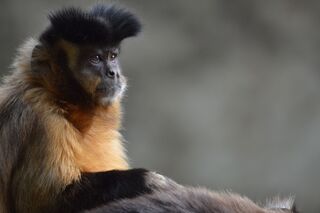Psychopharmacology
Why Do Monkeys Rub Themselves, and Others, With Onions?
Anointing behavior may serve both medicinal and social functions.
Posted August 18, 2022 Reviewed by Lybi Ma
Key points
- Anointing is a behavior in which animals rub substances into their bodies or fur, and it can be done individually or socially.
- Researchers used social network analysis to investigate how anointing impacts social relationships in two groups of capuchin monkeys.
- Results suggest anointing can contribute to mediating social relationships, but group structure and composition may also be factors.
- Social anointing may be analogous to social grooming, in that both behaviors have anti-parasite benefits and serve social functions.

Across the animal kingdom, numerous species engage in a behavior known as anointing. This is where animals rub pungent materials into their bodies or fur. Fish, reptiles, birds, and mammals all anoint using varied materials, including plants, mud, invertebrates, and artificial substances found in their habitat.
Primates, in particular, engage in two kinds of anointing: individual anointing in which an animal treats its own body, and social anointing in which an animal rubs its body or anointing materials against another individual. Social anointing can allow animals to reach body parts that are normally inaccessible, suggesting that the behavior may have medicinal benefits, such as chemical defense against parasites. However, in highly social primates, anointing may also reinforce or strengthen social bonds.
If You Give a Monkey an Onion
In an earlier study led by University of Suffolk biologist Mark Bowler, researchers found that captive capuchin monkeys use social anointing to target body parts that they could not reach on their own.
“We knew the capuchin monkeys at Edinburgh Zoo anointed, and we were interested in the social aspects of the behavior,” says primatologist Emily Messer of Heriot-Watt University, a co-author of the study. “Social influences are incredibly important in many species, as they can impact behavioral outcomes and social dynamics in groups.”
To investigate the social bonding functions of anointing, Messer, Bowler, and colleagues tested the Edinburgh Zoo capuchins again, this time using social network analysis to study their social structure before, during, and after anointing.
The researchers presented two capuchin groups with either a limited quantity (the rare resource condition) or a larger quantity (the abundant resource condition) of white onions. Onions are known to produce antibacterial and antifungal substances. “If a capuchin monkey in our research group is supplied with an onion, it will reliably bite into it and vigorously rub the exudates over its body, often also anointing socially with group mates,” Messer and her colleagues write in the paper. (Watch a video of the monkeys anointing here.)

The researchers measured social relationships in the monkeys by comparing proximity patterns when no onions were present (baseline), during the anointing sessions, and after anointing (once the monkeys were done interacting with the onions).
Complex Social Dynamics
Overall, the capuchin monkeys “enthusiastically” anointed whether resource density was high or low. However, the effect of anointing on social dynamics differed between the two groups, perhaps reflecting the complex nature of capuchin social organization.
In one group, known as the West group, monkeys had stronger associations or more associations with their group mates after anointing than in the baseline condition, whether the onions were rare or plentiful. This suggests that anointing can mediate social relationships, since monkeys did not need to increase proximity to anoint in the abundant resource condition, yet they did anyway. In addition, their associations were highest after anointing when onions were abundant, demonstrating that the monkeys chose to continue to associate together even after anointing.

While associations with group members were higher after anointing regardless of the amount of onion for the West group, a different pattern emerged in the East group. Among these monkeys, associations increased only after anointing in the rare resource condition. This shows that the monkeys remained closer together than in the baseline condition after anointing only when they would have had to come close together to access the limited anointing materials.
Messer says this difference between West and East groups may be due to differing social dynamics. “We think the relatedness of individuals in our two groups may have contributed to the differences we saw between them,” she says. “The West group had one main matriline and two unrelated adult males, whereas the East group had two main matrilines and two unrelated adult males.” Thus, the West group monkeys had a higher level of overall relatedness between individuals than the East group monkeys.

Social Medication
The researchers coined the term “social medication” to describe social anointing in capuchin monkeys to indicate that the behavior has both medicinal and social functions.
Messer and colleagues compare anointing to another common monkey behavior: Grooming. Both anointing and grooming appear to serve various hygiene and social functions and both behaviors can be done individually or socially.
This perspective on anointing avoids treating medicinal and social explanations for the behavior as mutually exclusive. There is increasing evidence that anointing may confer medical or health benefits. But in addition to that, Messer and colleagues write, “Like grooming, anointing in capuchin monkeys has evolved within the context of a highly complex repertoire of social behaviors and may have taken on an additional social function.”
References
Bowler, M., Messer, E., Claidière, N., and Whiten, A. (2015). Mutual medication in capuchin monkeys – Social anointing improves coverage of topically applied anti-parasite medicines. Scientific Reports 5: 15030. Doi: 10.1038/srep15030.
Messer EJE, Bowler MT, Claidière N, Whiten A. (2022). The role of anointing in robust capuchin monkey, Sapajus apella, social dynamics. Animal Behaviour 190: 103-114. Doi: 10.1016/j.anbehav.2022.04.017.




